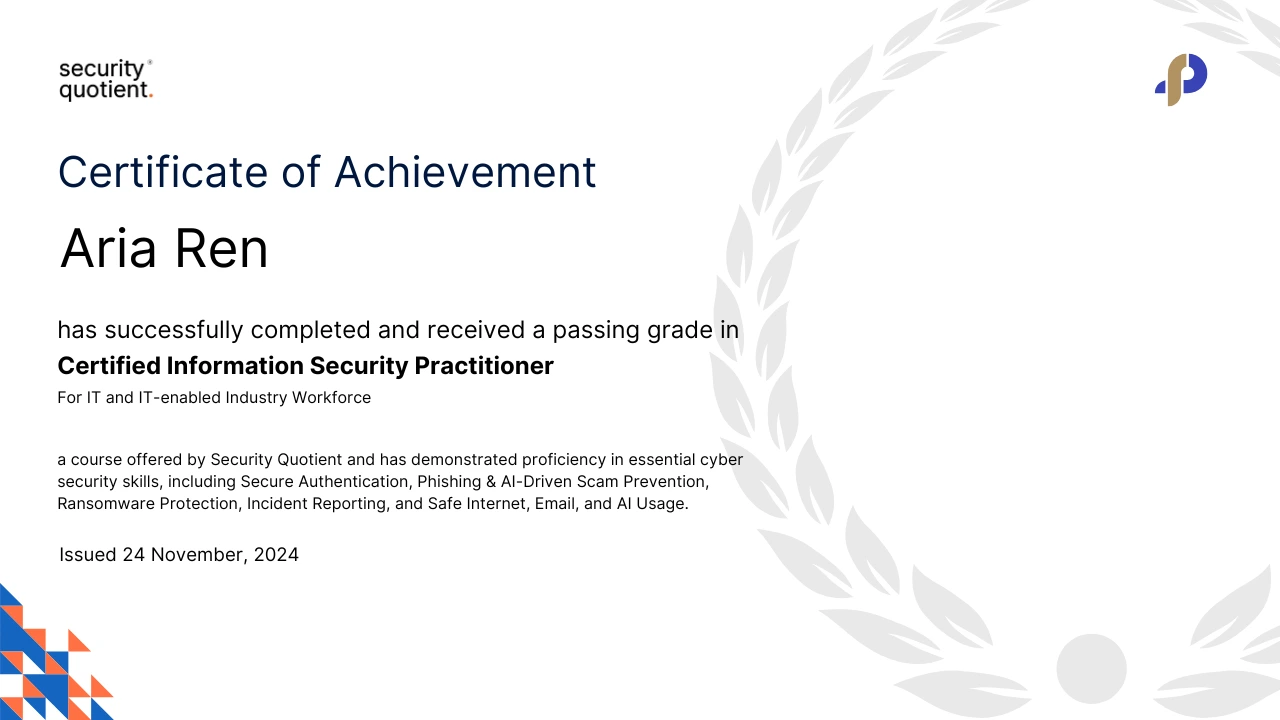Security Awareness Course
Certified Cyber Security Practitioner: BFSI
Security Awareness Training for Banking, Financial Services, and Insurance (BFSI)
A specialized cyber security awareness course designed for financial professionals, fintech employees, and payment service providers, focusing on protecting customer data, financial transactions, and digital banking infrastructure.
Why this Course?
Cyber Security is a business-critical concern in the BFSI industry, impacting financial stability, regulatory compliance, and customer trust. Employees across departments must be aware of cyber risks affecting financial transactions, data privacy, and digital banking security.
This course equips BFSI employees with the knowledge and practical skills required to recognize financial cyber threats, follow industry best practices, and support compliance with financial security regulations such as PCI DSS, GDPR, ISO 27001, FFIEC, MAS TRM, BNM RMiT, and RBI Cyber Security Framework for Banks. Through scenario-based learning, employees will gain real-world cyber security skills to help prevent fraud, protect customer data, and enhance their organization’s security posture.
Designed for Financial & Payments Security
Covers cyber security risks specific to banking, fintech, payments, and insurance.
Fraud Prevention & Incident Response
Helps employees recognize financial fraud, social engineering, and phishing scams before they escalate.
Compliance-Driven Training
Supports security awareness requirements under PCI DSS, ISO 27001, GDPR, FFIEC, MAS TRM, BNM RMiT, and RBI Cyber Security Framework for Banks.
Real-World Threat Scenarios
Provides actionable cyber security insights for handling fraudulent transactions, identity theft, and insider threats.
Target Audience
This course is designed for employees in banking, financial services, insurance, fintech, and payments, ensuring they can identify and mitigate cyber threats in their daily operations. It is ideal for:
– Banking and financial professionals managing customer transactions and financial operations.
– Insurance and claims processing teams handling sensitive customer data and digital records.
– Fintech and payment service employees securing digital transactions and payment ecosystems.
– HR, Marketing, and Customer Support teams handling financial data and client interactions.
– Relationship managers and financial advisors working with wealth management and investment platforms.
– Risk, compliance, and security teams responsible for regulatory adherence and fraud prevention.
No prior cyber security knowledge is required—this course provides role-based training to help all employees contribute to ICS/OT security and compliance efforts.

Course Content
Cyber Security is a business-critical concern in the BFSI industry, impacting financial stability, regulatory compliance, and customer trust. Employees across departments must be aware of cyber risks affecting financial transactions, data privacy, and digital banking security.
Section 1: Understanding the BFSI Cyber Threat Landscape
– Overview of cyber threats targeting financial institutions, fintech, and payment platforms.
– Case studies on bank fraud, identity theft, and payment system breaches.
– The impact of cyberattacks on customer trust, financial losses, and regulatory penalties.
Section 2. Modern Cyber Threats, Prevention, and Incident Response
– Recognizing real-world financial cyber threats, including phishing, AI-driven scams, and payment fraud.
– Proactive fraud prevention strategies, including secure authentication and transaction monitoring.
– Incident response essentials: detecting, reporting, and responding to unauthorized transactions and security breaches.
Section 3. Key Standards and Frameworks in the BFSI Industry
The BFSI sector is heavily regulated to ensure the security of financial transactions, customer data, and digital banking operations. This module provides an overview of key security standards, compliance frameworks, and regulatory requirements, helping organizations mitigate cyber risks and prevent financial fraud.
– PCI DSS (Payment Card Industry Data Security Standard) – A global standard ensuring the security of payment card transactions and customer financial data.
– ISO 27001 & GDPR – International standards for information security management and data privacy compliance – adopted by financial institutions.
– FFIEC (Federal Financial Institutions Examination Council) – U.S. cyber security guidelines for banks and financial institutions.
– MAS TRM (Monetary Authority of Singapore Technology Risk Management Guidelines) – A security framework ensuring fintech and banking resilience in Singapore.
– BNM RMiT (Risk Management in Technology, Malaysia) – Cyber Security and risk management guidelines issued by Bank Negara Malaysia (BNM) to strengthen financial institutions’ technology risk management and operational resilience.
– RBI Cyber Security Framework for Banks (2016) – Issued by the Reserve Bank of India (RBI), this framework mandates cyber security controls for Indian banks, including risk assessment, fraud monitoring, secure authentication, and incident response protocols.
Section 4. Cyber Security Best Practices & Incident Preparedness in BFSI
This section covers 10 critical cyber security best practices, tailored to employees working in banking, financial services, and payments:
4.1. Secure Authentication
Strengthening authentication processes with multi-factor authentication (MFA) and biometric verification to prevent fraudulent account access.
4.2. Identifying and Avoiding Phishing & AI-Driven Scams
How fraudsters use email scams, fake financial portals, and social engineering tactics to steal customer data and banking credentials.
4.3. Preventing and Responding to Ransomware Attacks
Understanding the risk of ransomware attacks targeting financial databases, and implementing secure backups and incident response protocols.
4.4. Identifying and Reporting Cyber Security Incidents
The importance of real-time fraud detection, monitoring suspicious transactions, and reporting anomalies to prevent financial loss.
4.5. Safe Internet and Email Practices
Avoiding malware infections by identifying fraudulent emails, preventing unauthorized downloads, and securing financial communication channels.
4.6. Preventing Data Mishandling & Unauthorized Access
Ensuring secure handling of customer financial data, encryption of transaction records, and compliance with GDPR and PCI DSS.
4.7. Securing Your Mobile Devices
Protecting mobile banking applications, payment processing devices, and remote financial workstations from unauthorized access and fraud.
4.8. Securing Remote Work Environments
Ensuring secure VPN access for remote financial employees, reducing the risk of data interception and unauthorized transactions.
4.9. Safe Social Media Use
Preventing fraudsters from gathering intelligence on financial institutions, employees, and VIP clients through social engineering and data leaks.
4.10. Safe AI Usage Practices
Using AI-driven financial services and automation tools responsibly, ensuring compliance with security and regulatory frameworks.
5. Summary and Results
– Recap of key cyber security practices for BFSI professionals.
– Review of learner progress and assessment results to measure knowledge retention.
– Reinforcing the importance of continuous cyber security awareness in financial services.
Certification for Successful Learners
Recognize and reward employees who successfully complete the course with a company-branded certificate, reinforcing their commitment to cyber security.
Minimum Passing Score – 80%
Learners who score 80% or higher receive an official co-branded certificate#.
Digital & Shareable
Learners can showcase their achievement internally or on platforms like LinkedIn.
Drive Engagement
Providing certification motivates employees to adopt security best practices.
Company-Branded Certificate#
Each certificate is customized with your organization’s name.

Sample certificate with client logo co-branding
# Client logo co-branding is available only in Premium and Enterprise Plans.
Assessment Method
Instead of relying on a single final test, assessments are integrated throughout the course to measure understanding and promote continuous learning. Participants will apply their knowledge in scenario-based challenges, encouraging critical thinking and secure decision-making in business contexts.
Continuous Assessments
Integrated assessments at the end of each section.
Scenario-Based Decision-Making
Real-world simulations instead of multiple-choice questions.
Pass Score
A score of 80% or more is required to pass the course.
No Final Test
Learn progressively with assessments throughout the course.
Course Features
A time-sensitive and concise course designed for professionals. Accessible on any device, with integrated assessments for practical learning.
Interactive E-Learning
Scenario-based, interactive content for real-world application.
Learning Time – 45 Minutes
Quick, focused learning with minimal disruption to work.
Delivery via Secure LMS
Hosted on our LMS for seamless access and tracking.
Mobile Responsive
Fully accessible across all devices for flexible learning.
How to Get This Course?
All our courses are available as part of our subscription plans.
Equip your workforce with essential cyber security skills through our flexible subscription plans. Our plans include:
– Full Access to All Courses – Get unlimited access to our entire training library containing courses and micro-learning.
– Progress Tracking & Analytics – Monitor employee progress with detailed insights.
– Company-Branded Certification – Recognize and certify successful learners#.
– Advanced Behaviour Analytics – Delve deep into learning data to identify poor cyber security behaviours and its impact#.
– Expert Support – Dedicated assistance to help you implement training effectively.
# Available in advanced plans.

